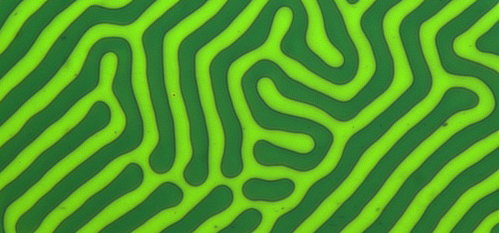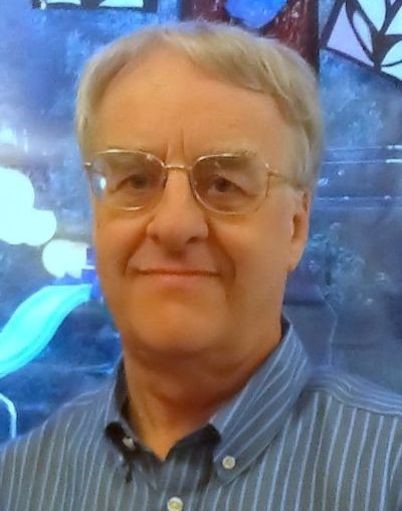
Magnetic domains viewed by the Faraday Effect © Matesy GmbH, Creative Commons Attribution-Share Alike 3.0 Unported license.
When I was a Physics student, I used to tear down the posters of the University Christian Union (CU). It was an unexpected moment for me therefore when I found faith and became a Christian, while I was working on a PhD in magnetic domain theory. In the early hours of the morning of the seventh of May 1971, alone in my room, God showed me how much I needed him.
I sometimes feel my experience has parallels to that of Saul meeting Jesus in Acts 9. There were no lights or voices, just a sudden feeling of an urgent need for meaning to my life and how my rejection of Jesus prevented this. “Please help me” was followed by a feeling of peace and then tiredness so I slept and the next morning, the view from my bedroom window seemed more beautiful than I remembered. One immediate change people noticed was that I completely stopped swearing although it took a while for some to accept that I had really found faith in Jesus.
For those who wonder if God has a sense of humour I have now been very happily married for the last forty-three years to the person who was putting the CU posters up!
After my PhD I spent a further three years as a research fellow at the university before continuing a career in scientific research in the electronics industry for thirty-four years, retiring in 2009. During this time I worked first on a technology known as a magnetic bubble memory (eventually overtaken by cheaper silicon devices) and also on thermal management problems in electronics which became increasingly important as the speed of operation increased at the same time as devices became smaller.
At the start of my faith journey I was more concerned to learn about my new-found Christian faith than worrying about how it fitted with science. For many years I kept the two areas quite separate in my thinking.
As time passed I realised that I could no longer continue with what I came to realise was the sterile ‘cop-out’ of keeping science and faith in separate compartments. One reason for this was seeing the aggressive opposition to the Christian faith promoted by media icons such as Richard Dawkins and Christopher Hitchens which seemed to be uncritically accepted by many people. Their assertions that religion should be regarded as a malevolent force to be totally opposed and eradicated, and that our faith should be in science to eventually provide absolutely true answers to everything, forced me to start my continuing journey to try and understand how science and faith fitted together. It was at this time that I joined Christians in Science.
With the help of a number of thinkers and writers such as Alister McGrath[i] and Ian Barbour[ii] I came to view Faith and Science as complementary. Together I found that the different perspectives of truth, which science and faith provide, enhance our view of existence and enrich our search for meaning. I find it helpful, when challenged with the assertion that science does or will one day provide all the answers we need, to remember that true science is always provisional. This is well illustrated by Newtonian mechanics which is ‘true’ to the extent that it can describe extremely accurately the motion of objects including the planets of our solar system. However, it breaks down entirely at the small scale of the atomic and sub-atomic realm. Newtonian mechanics are not wrong – they are just not the whole story.
For me, two scientific developments in the last hundred years have special significance in showing that science is not the enemy of faith. The first was when, in the 1920s, the Belgian catholic priest and highly gifted scientist Georges Le Maître showed that the accepted infinite steady state view of the universe was not correct. This picture of our universe was much beloved of atheist scientists of the time since they believed it ruled out the need for creation. He proposed a theory that we live in an expanding universe, implying that it must have expanded from a point of origin (or of creation). I’m not saying, of course, that this therefore requires God to exist, as Le Maître himself was concerned to point out at the time including, in 1952, to Pope Pius XII who claimed the discovery confirmed the Christian doctrine of creation.
The second is the more recent discovery that the processes involved in our universe require to be incredibly finely tuned to enable creation itself and also to be able to sustain life. Rodney Holder’s book, referenced below, describes both these theories in more detail.[iii]
I’m left today with a sense of wonder when I think about the creation within which God has set us, and then consider the amazing and unique combination of curiosity and intelligence which allows us humans to uniquely make some sense of how it functions. This is beautifully summarised in Psalm 8, to which my response is one of praise and worship to the gracious God who has allow us also to say with the psalmist “When I consider your heavens …”
 Paul Cooper is a retired research scientist. Following nine years at Nottingham University he continued working in scientific research for the next thirty-four years including leading a number of large multi-national scientific research projects involving universities and technology companies in Europe, the US and Japan. He has worked in various fields including electronics, materials, metrology, system reliability, information technology and networks, manufacturing processes and simulation. He retired in 2009 since when he has pursued a long standing interest in the interface between science and faith. He has been an active member of St Giles Church in Northampton for forty-three years.
Paul Cooper is a retired research scientist. Following nine years at Nottingham University he continued working in scientific research for the next thirty-four years including leading a number of large multi-national scientific research projects involving universities and technology companies in Europe, the US and Japan. He has worked in various fields including electronics, materials, metrology, system reliability, information technology and networks, manufacturing processes and simulation. He retired in 2009 since when he has pursued a long standing interest in the interface between science and faith. He has been an active member of St Giles Church in Northampton for forty-three years.
[i] Many online videos and books most recently “The Great Mystery” (John Murray Press 2017).
[ii] Ian Barbour, “When Science meets Religion” (Harper Collins 2000)
[iii] Rodney Holder, “Big Bang Big God” (Lion Hudson 2013)




